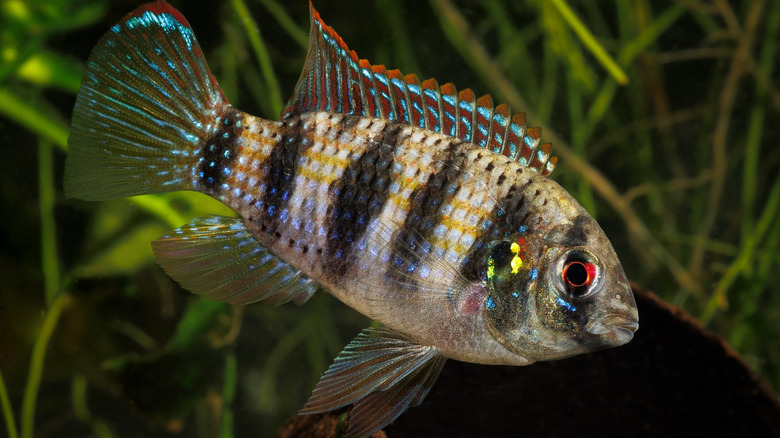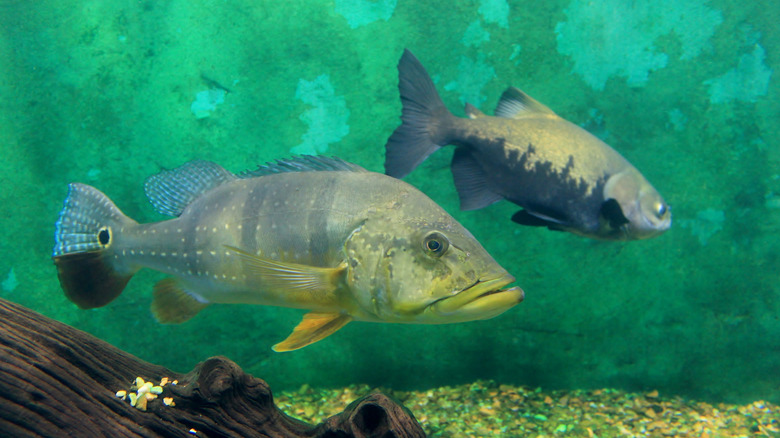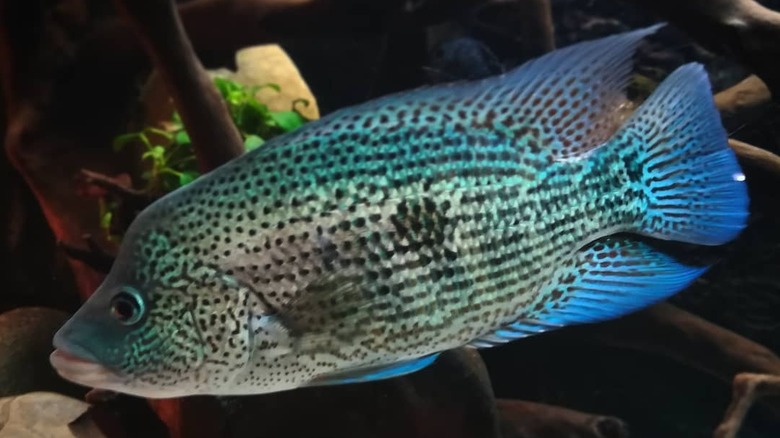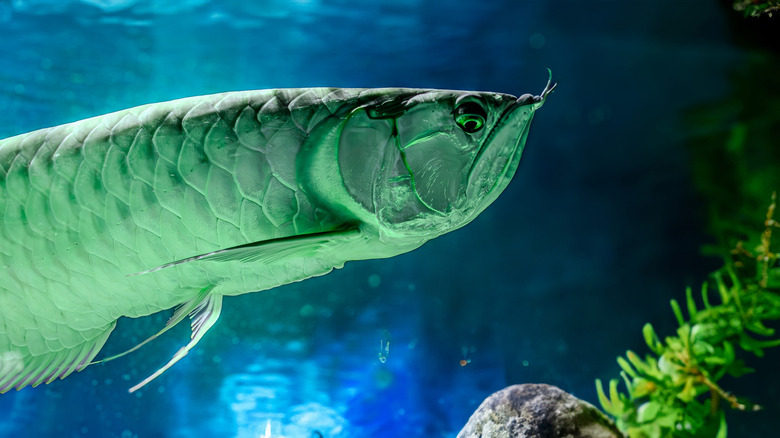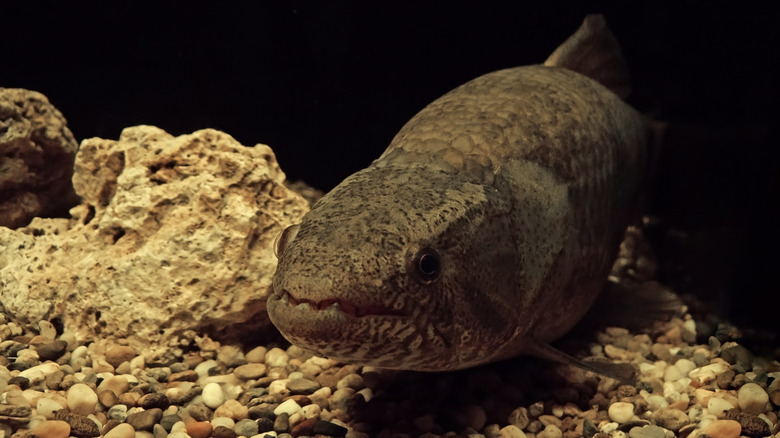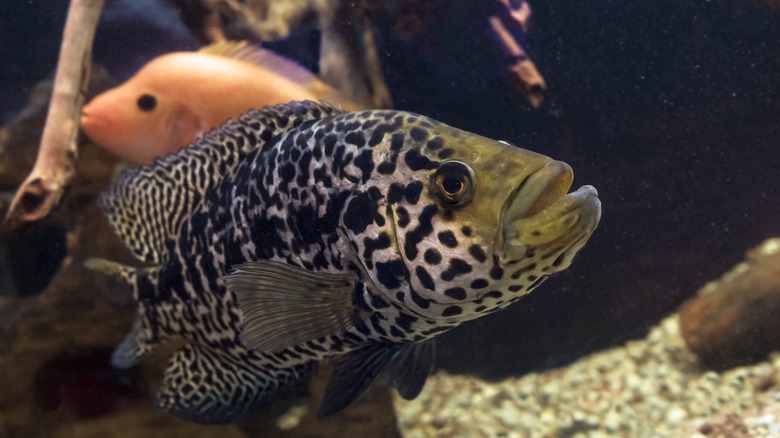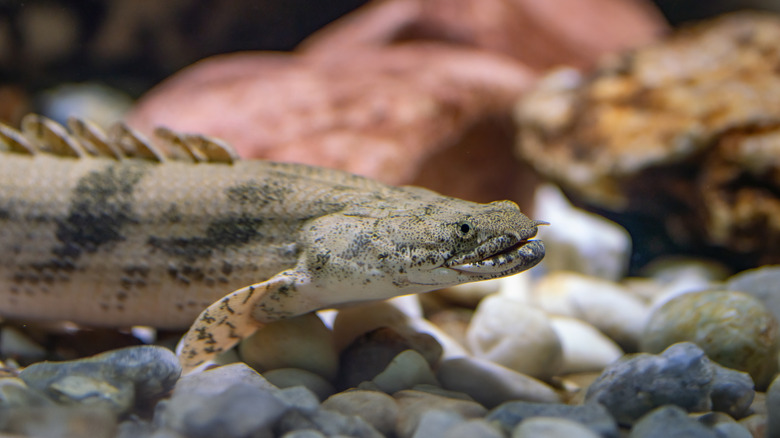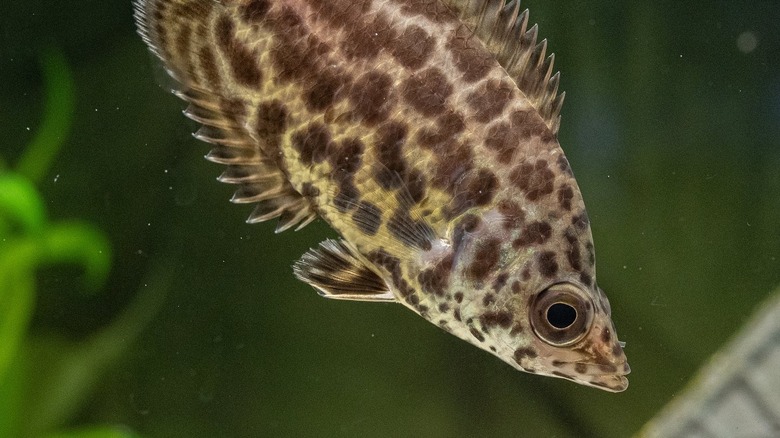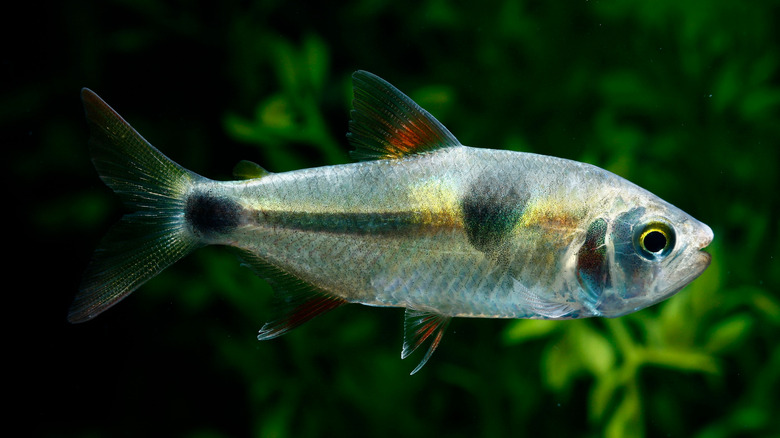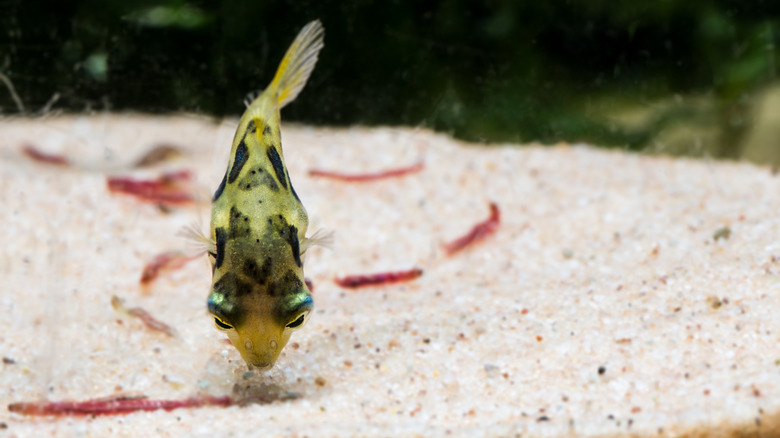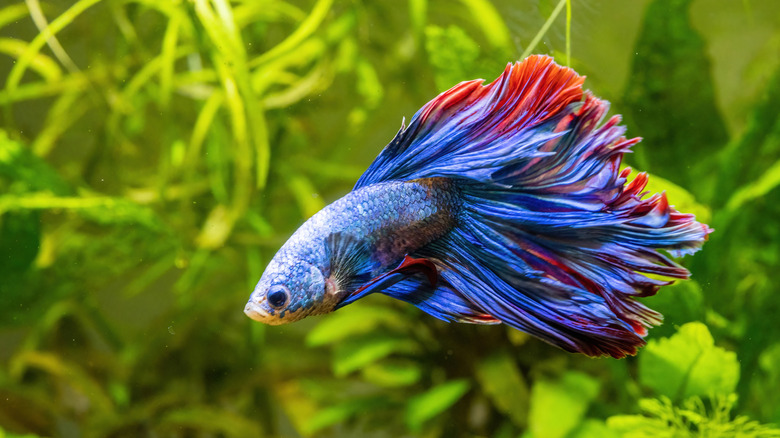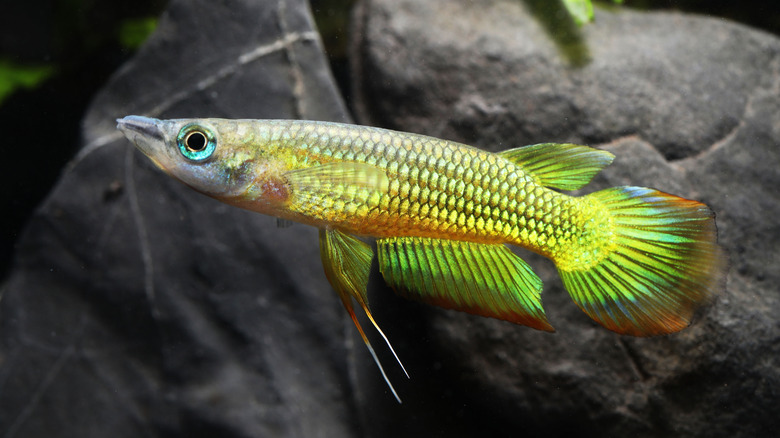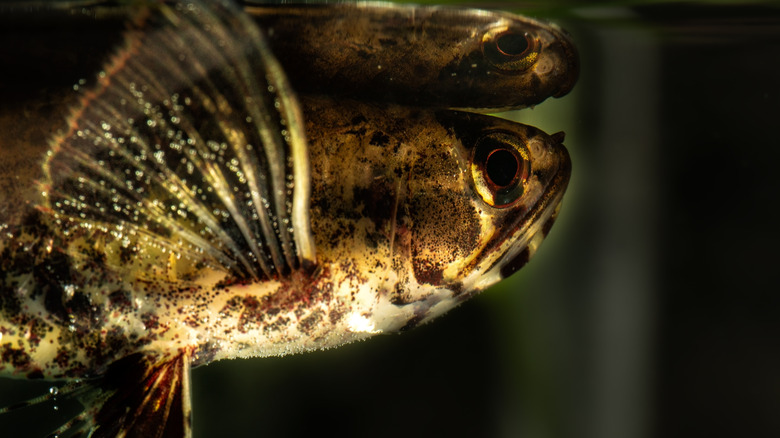Top 13 Predatory Aquarium Fish, According To Owners
Fishkeeping is a thrilling hobby, and aquarists have countless species to choose from. Popular categories include community fish, livebearers, coldwater, saltwater, exotic, and predatory. Although they typically come with more advanced care requirements, many people are drawn to predatory aquarium fish because of their fascinating behaviors, unique personalities, colorful and patterned skin, and hunting abilities. These fish range in size, but they all use their senses to hunt and catch prey, such as smaller fish, bloodworms, or shrimp. They often hide in their environment, watching and waiting to pounce on their next meal.
We've relied on the accounts of experienced fish owners in the Aquariums subreddit and a few other online forums to find the top predatory breeds. We'll also discuss why they're so popular, as well as the pros and cons of each. Although the order may differ for others depending on individual preference, we've ranked each predatory fish according to their interactive behavior, appearance, ease of care, and compatibility.
13. Peacock bass
The peacock bass has an impressive size of around 29 inches, but usually only hits 24 inches when housed in an aquarium. These large predatory fish require large aquariums or indoor ponds with excellent filtration systems, as they make a lot of mess when they eat. Auballagh pointed out on cichlid-forum: "It has almost zero tolerance for just about any Nitrate buildup in the water of an aquarium." As a result, owners must do partial water changes frequently.
The peacock bass has an interesting look thanks to its patterned skin and unique "eyespot" marking on its tail. According to Redditor Tsuyoi, they're also fascinating to watch, "especially if you feed live bait," as they're voracious predators. Their diet consists of live or frozen fish, crickets, mealworms, carnivore pellets, and frozen shrimp, bloodworms, or krill, per Pet Zone Tropical Fish.
These fish are naturally aggressive, especially over their territory, so they should never be kept in a tank with another male. They do best on their own or with a mated pair but can coexist with other large, robust fish. However, they will likely eat any fish smaller than them. Due to their particular needs and water quality sensitivity, peacock bass are not suitable for anyone other than highly-experienced fishkeepers with the budget, time, and knowledge for the type of aquarium setup and maintenance they require.
12. Wolf cichlid
Aquarists enjoy the wolf cichlid due to their pretty iridescent bodies. Males have more vibrant colors, grow larger in size, and often have a long black stripe. These fish can get as big as 28 inches, and need an aquarium size of at least 150 gallons with a water temperature between 75.2 to 82.4 degrees Fahrenheit, according to Maidenhead Aquatics.
The intelligent wolf cichlid provides an interactive experience. Reddit user hiketheplanet444 commented, "Seriously great fish!" and "They follow you around when you are in the room." However, they're very aggressive and eat smaller fish, so they should either be kept alone or with a mated pair. They'll even attack their owners' hands if they feel threatened or cornered. They prefer meaty foods, such as bloodworms, prawns, and crabs, but can also eat carnivorous pellets.
Like the peacock bass, the wolf cichlid is only recommended for experienced aquarists. They're hardy, but require a lot of maintenance, knowledge, and expensive equipment to keep.
11. Arowana
Arowana are ancient fish with massive, slender bodies, pearly scales, and pronounced jaws. Although this breed can grow bigger than 3 feet, they're prized by those who keep them. In fact, they're so valued amongst aquarium enthusiasts that some arowana species can cost around $300,000! However, just because they're costly, doesn't mean they're easy to care for — they need experienced owners to keep them happy and thriving.
As with most carnivorous predatory fish, arowanas are aggressive and prefer to live in aquariums alone. If you want to add tankmates, they must be fish who won't encroach on the arowana's territory near the water's surface. U/underthesunnynight suggests trying "bichirs, channa maru, red-tail cats, shovelnose catfish, alligator gars, big plecos," as these are "primarily bottom dwelling fish." As arowanas age, they tend to become tamer with their owners, and may even feel comfortable enough to eat food from their hands.
Arowanas need a minimum tank size of 150 gallons. They're sensitive to water temperature, and anything outside 72 to 82 degrees Fahrenheit (per PetMD) can shorten their lifespan or kill them. Young arowana must be fed up to three times a day, while adults only need a meal once a day. They enjoy live or frozen food such as shrimp, small fish, and black worms.
10. Afer knife
If you want to keep one monster fish, the Afer knife could be the breed for you; they don't do well in community tanks, even when shared with other Afer knives, as they're incredibly territorial. When one Afer knife owner asked why their Afer knife was being so aggressive to their other large fish, Jefffahfffah, a top 5% commenter, replied, "I'm not sure the knife will ever stop harassing tankmates." Afer knives will attack any fish they don't like, regardless of their species.
Afer knives are a sight to see, growing to 24 inches when kept in captivity; they can get much larger in their natural habitat and live up to 15 years. They also have an interesting, long body shape with pretty markings, which make them appealing to enthusiasts. They enjoy live fish or frozen food and may refuse to eat carnivorous pellets or flakes. Because their natural habitat is full of vegetation, these fish do well in tanks with plenty of plant life, many places to hide, and low lighting. Although they're prized and quite difficult to find, Afer knives are only suitable for experienced fishkeepers.
9. Hoplias aimara
Hoplias aimara are fish you should think twice about before adding to your aquarium if you're a beginner. Also known as the giant wolf fish, this breed is voracious and aggressive, requires high water quality, and has large, sharp teeth. Their jaws are powerful enough to crack open hard shells, which is convenient because they enjoy shrimp, mussels, squid, and other fish. They're not shy when it comes to feeding; although they wait quietly for their meal, they're fast predators when it's time to hunt. They're also interactive and communicative, as Redditor G00origonRaStt pointed out in a comment, "When he tells me it's feeding time, he's at the front of the tank, gills flared and flexing on me hard."
These fish are big and can get up to 12 to 14 inches in captivity. An interesting feature of Hoplias aimara is that they can breathe air, so when oxygen levels are low in their environment, they'll pop their heads above the surface and take a gulp! This allows them to survive in water bodies that many other fish would quickly die in, like murky ponds and swamps. Although Hoplias aimara are territorial, they can get along with other large fish who aren't aggressive.
8. Jaguar cichlid
The jaguar cichlid gets its name from its patterned skin and aggressive nature. Like jaguar cats, these cichlids like meat and will eat smaller fish placed in their aquarium. They're also large, reaching up to 21 inches. If you're curious about how fast cichlids grow, you'll be surprised to know that it's around an inch every month! They must eat once daily and enjoy frozen, dried, or live foods.
Jaguar cichlids are territorial and can nip at fish if they feel threatened, although they do best with other cichlids. They won't stop at attacking fish; some also come for their owners, with ohflyingcamera commenting on r/Cichlid, "One of my friends had a jag a while back. He would wear an armored glove when he put his hand in the tank to clean it because the fish would attack it. They are mean."
Further, it's important to ensure tanks containing jaguar cichlids have secure lids, as they're strong jumpers and can knock off a flimsy cover and end up on the floor along with it. Despite their challenges, these fish are well-loved among hobbyists because of their bright colors and patterns, interactive behavior, personality quirks, ability to differentiate between different people, and trainability.
7. Bichir
Bichirs are fascinating! They have a pair of lungs that allow them to survive in areas with low water levels and even outside of the water for a few hours. They have an eel-like body that gets up to 30 inches long, thick scales, many dorsal fins that line their back, and a cute face. They're natural hunters with a strong sense of smell. They also have a unique hunting method, using their pectoral fins to "walk" and capture prey. The biggest task owners of these fish have is cleaning up after them, as they're messy eaters. This also means that a strong filter for the tank is necessary.
Bichirs are hardy and relatively easy to care for, but they get startled easily and may jump, so a lid must stay on the tank at all times. Owners of these fish enjoy watching them because they're energetic and move all over their tanks, with lightninbug8684 from r/Aquariums saying, "Exactly one of the reasons why I love this fish so much, ZERO maintenance, just sit back and enjoy." Their tanks should be at least 90 gallons big and at a temperature of 72 to 82 degrees Fahrenheit, according to Blue Dog Aquatics. They enjoy live fish and can share tanks with other large, predatory fish.
6. African leaf fish
African leaf fish like to eat, and although they're only around 6-8 inches in size, they will eat small to medium-sized fish as they see anything smaller than themselves as a meal, which makes for a very interesting watch for owners. Although they're little killers, owners of these fish dote on how cute they are, with Weavercat on r/Aquariums jokingly commenting, "Oh no, this little cutie can have anything it wants. My soul, my savings, my house. This fish stared into my heart and demanded... assets" to a picture of an African leaf fish.
African leaf fish are a great option for people starting out in predatory fishkeeping as they're easy to care for. They enjoy having many driftwood and rocks as hiding spots in their tank, along with vegetation that they will camouflage into with their leaf-like appearance. They do well in 50-gallon tanks at a temperature at or slightly above 78 degrees Fahrenheit that are dimly lit (via Seriously Fish). They can share a tank with fish that are too big to fit into their mouths and aren't aggressive in nature.
5. Bucktooth tetra
The bucktooth tetra usually only grows to 5 inches long but is a big bully, even to fish much bigger in size. Capybara_Chill_00 on r/Fish shared that their bucktooth tetras attacked their piranhas, commenting, "They stripped the scales off the carcasses and then ignored them." Eating the scales of other fish instead of the whole body is a characteristic of this species, but they also enjoy insects, mussels, crustaceans, and pellets on occasion.
Bucktooth tetra does best on its own or in large groups of 20 or more bucktooths, which is a stunning visual because they're brightly colored. Although they don't take kindly to most other types of fish, there are a few good tank mates for tetras, such as large anostomus. These fish live in tank sizes of 55 gallons or more in temperatures of 72 to 82 degrees Fahrenheit (via Fishkeeping World). Although their aggression comes with some challenges, these fish are suitable for intermediate hobbyists, as they're pretty hardy.
4. Dwarf pea puffer
Dwarf pea puffers are round with spots and are the smallest of their kind, growing only an inch long. Although small, these fish are very territorial and aggressive toward other fish, even larger types, and do best on their own or in a tank with other dwarf pea puffers. They like environments with a lot of plant life to hide in and wait for prey. For one dwarf pea puffer, a 10-gallon tank with a water temperature of 72 to 82 degrees Fahrenheit is appropriate (via Tankarium).
They're very interactive, can recognize their owners, and are curious about life outside of their tank. They even have their own personalities and unique swimming patterns, which makes identifying each one easier for the owner. They're adaptable but very sensitive to water quality and refuse to eat pellets or flakes, so you will have to feed them protein, such as Ramshorn snails, mosquito larvae, and bloodworms. Due to their specific needs, a knowledgeable fishkeeper is best suited for them. Banoatmeal advised other fish owners in r/PeaPuffers, "Only get ones that are healthy looking with round bellies, good colors, and not too small."
3. Betta fish
Betta fish are small, stunning predator fish that are very sensitive, prone to stress, and need an enriching environment to thrive. They're an extremely popular fish that beginners should keep out of their aquarium because they're widely misunderstood, especially when it comes to their diet and living space. Although many believe these fish can survive in mugs and small vases, betta fish shouldn't live in anything smaller than a 10-gallon tank at 76 to 82 degrees Fahrenheit, per PETA. They also primarily eat insects and larvae, not plant roots.
Betta fish are interactive and have their own personalities, as described by gd2234 in r/bettafish: "I've had four personality types at this point: angry, sassy, idiot, and puppy." They also usually favor the person who feeds them and will follow them as they move from one side of the room to the other. They can live with a few other fish, such as tetras, but shouldn't be housed with another male betta fish, as they're very territorial.
2. Killifish
Killifish are colorful with stripes or spots. Depending on the species, looking after killifish ranges from easy to difficult, with some species growing to 6 inches long, but most are smaller. Most killifish have a lifespan of around three years, but annual killifish only live up to a year. Females can live together, but more than one male killifish in an aquarium will likely result in fighting. M_tisdale from r/Aquarium points out why these fish are one of the top predatory aquarium fish when they say, "They are very interesting fish both with color and behavior."
When you think about what type of fish eat shrimp, think of the killifish because they love hunting live shrimp, which is partly why they're a favorite amongst predatory fishkeepers — they're entertaining to watch. Trying to find a killifish at your local pet store will be difficult, as they're not well-known, but these underrated fish quickly win over anyone who encounters them. Depending on their size, they can be happy in smaller tanks between 5 to 10 gallons with a temperature of 68 to 75 degrees Fahrenheit (via Aqueon).
1. African butterfly fish
The African butterfly fish is a favorite among enthusiasts because of its unique features. Most noticeable are their pectoral fins, which resemble the wings of a butterfly. They're also known to jump out of the water and "fly" through the air to catch their prey. They wait patiently for their prey to come close before quickly attacking it, taking on an ambush approach. These fish enjoy live insects but will also eat bloodworms and shrimp that are hand-given to them on the surface of the water. Sheepskin from r/Aquariums suggests adding a water lily to their tank because "they love to sit in the gap of the leaf and pick things up from on the leaf."
Although males can become territorial, they're not particularly violent and can share a tank with many types of fish as long as they're bigger than them, as they tend to swallow smaller fish. However, African butterfly fish tend to be bullied by fin-nippers, so avoid adding these to their tanks. Otherwise, try ways to stop fish bullying, such as getting a bigger tank or adding more hiding spots. These fish can get up to 5 inches and are happy in a 30-gallon tank. The best news is that they can be enjoyed by all hobbyists, even beginners.
Methodology
Although some predatory fishkeepers will agree with our ranking and some won't, it all boils down to personal preference, experience, tank size, aquarium setup, budget, appearance, and behavior. We compiled our list based on the experiences and preferences of fish owners in the r/Aquarium Reddit community using four main criteria: interactive behavior, appearance, ease of care, and compatibility.
For interactive behavior, we looked at any quirks or behaviors the fish may have, such as following their owners, notable hunting methods, different personalities, and being able to communicate their needs in some capacity. The more interactive a predatory fish is, the more appealing they are to owners. Appearance is also a huge draw to most aquarists because colors and patterns liven up aquariums. However, the size of a fish and any unique features can also make them more appealing. Size does come with drawbacks, though. Large fish are expensive and need big tanks with strong filtration systems, which are costly, heavy, and take up a lot of space. They usually require more maintenance, such as frequent water changes, because they produce a greater amount of waste, which is time-consuming for the owner. Additionally, they tend to eat more specific diets consisting of live fish, which is also expensive.
Certain fish aren't compatible with others or even their own species. Some can share a tank with a mate or a group of their own species, and other types are compatible with community tanks. Although some aquarists are happy to own one fish or have a tank with many fish of the same species, others want compatible options. Having a tank filled with multiple types of fish is exciting because you have a variety of personalities, appearances, and interactions. When choosing predatory fish, consider your needs, budget, and preferences.
